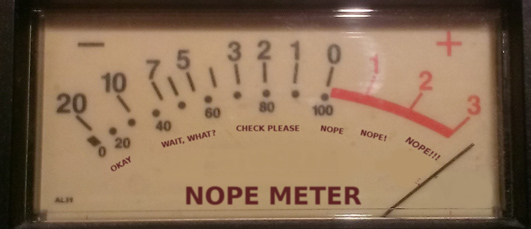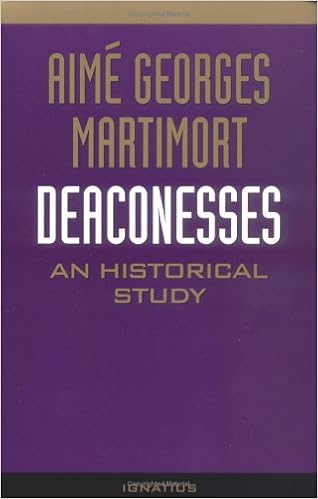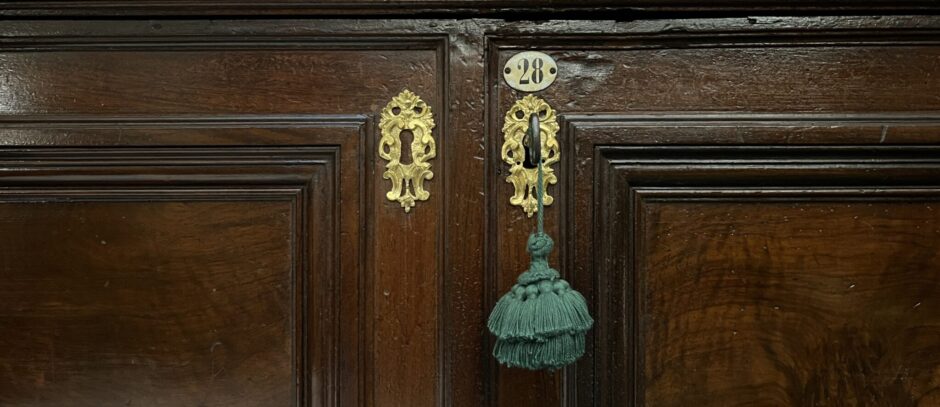 My inbox is being pelted with a story that some Armenian Orthodox bishop in Tehran “ordained” a female deacon. For example HERE and HERE.
My inbox is being pelted with a story that some Armenian Orthodox bishop in Tehran “ordained” a female deacon. For example HERE and HERE.
To which I respond:
Ho hum.
First, I’m not sure that we care much about a single Armenian bishop does in Tehran.
Secondly, the claim in the story is that Armenians had a long tradition of ordaining deaconettes. Oh, really? Then why is this a big story?
Thirdly, if they had them, and then they disappeared… maybe there’s a good reason.
Fourthly, you can’t simply declare something to be a long-standing tradition.
The best thing written to date about women and the diaconate, Deaconesses: An Historical Study by Aime G. Martimort (French 1982 & English – Ignatius Press, 1986) [US HERE – UK HERE] has a chapter: “Were there deaconesses among the Armenians and Georgians?”
The answer is as you have already guessed.
As Martimort explains, there isn’t any reliable evidence for their early practice. Moreover, they were explicitly forbidden from the 5th century onward. In the 12th c. there was discussion of deaconettes in strict cloisters, but reading on in Martimort we find that even that seems dodgy. Martimort concludes:
“Even though it is not always easy to fix the exact date of its desuetude in the various churches, it does seem pretty clear that, by the end of the tenth or eleventh centuries, deaconesses had pretty much disappeared in the East, even though the memory of them continued, anachronistically, to be revived in the recopying of liturgical books, and – in a defective and imprecise fashion – in the tradition of canonists.”
“But Father! But Father!”, you libs bellow from your fainting couches and behind your quivering fans, “You are always talking about TRADITION! Here they are using their tradition! Right? So, you are a hypocritical, patriarchalist who clings to laws and … and … YOU HATE VATICAN II!”
Deaconettes… nope.
A former professor of mine in Rome, Fr. Giles Pelland, SJ explains:
In order to speak of a “tradition” or “practice” of the Church, it is not enough to point out a certain number of cases spread over a period of four or five centuries. One would have to show, insofar as one can, that these cases correspond to a practice accepted by the Church at the time. Otherwise, we would only have the opinion of a theologian (however prestigious), or information about a local tradition at a certain moment in its history—which obviously does not have the same weight.
In a nutshell, it is possible to find any number of isolated incidents of this or that aberrant practice in the ancient Church. We see this in our own day. Just because some group does or says X today doesn’t mean that it is accepted Catholic practice or teaching. A serious problem arises when you try to found your arguments on those isolated aberrant practices as if they were accepted.
Everyone… just refer the promoters of deaconettes to Martimort. It is a little dated, now, but it is at least sober and fair.

The Pelland quote, by the way, comes from a discussion of ancient marriage and divorce practices, but it is entirely appropriate for other discussions of ancient practice as well. Gilles Pelland, S.J., “Did the Church Treat the Divorced and Remarried More Leniently in Antiquity than Today?”, L’Osservatore Romano, English Edition, February 2, 2000, p. 9. Quoted in the magnificent, highly useful, deeply influential, hated by libs, stolen from Synod mailboxes, Remaining in the Truth of Christ: Marriage and Communion in the Catholic Church (in English by Ignatius Press HERE – UK link HERE).
UPDATE:
Not everyone is on board. HERE


































These are non-Chalcedonions, not Orthodox, just for anyone here who might be confused. [So, even less significant.] This has been recently addressed in the Orthodox Church: http://byztex.blogspot.com/2018/01/eminent-clergy-theologians-voice.html [Which link I’ve posted at the end of the post.]
I hope her name is not Kardashian.
Agreed, who cares about a solitary Armenian bishop. If it were to happen in the Catholic Church, I believe there would be a major revolt, especially in light of every thing else that has unfolded.
[Yawn.]
I would caution against venturing too far toward the error of historicism, in that whether you believe the historians who support the past existence of female deacons or those who don’t, the fact that the Church did or did not do something earlier does not alone argue that is can or cannot do the same today. The Church has always grown in insight and adapted to circumstance, if it did not we would still be circumcising adult male catechumens. So, it seems to be the argument from history is entirely relative; and the theological arguments against the ordination of women deacons (or priests as far as I am concerned) are really not very convincing.
[The theological arguments are not very convincing, they are entirely convincing.]
It needs to be said, that to the degree that an office of deaconess existed, it was (and arguably is) primarily an Eastern phenomenon, even as understood to be distinct from the male diaconate. The office never really took hold in the West. As to the Armenians, there is indeed ample evidence of their legitimate existence, and not only in the first millennium.
”In the Armenian Church tradition, the development of the office of female diaconate is divided into four historical periods according to Fr. Abel Oghlukian, the author of a study on the subject: (a) 4th-8th centuries in Greater Armenia; (b) 9th-11th centuries in Eastern and Cilician Armenia, where the term ‘deaconess’ is included in the book of ordination (??????); (c) 12th century and on, where there are literary references and rites for the ordination of deaconesses in liturgical texts in Cilicia and eastern Armenia; and (d) 17th century renewal of female diaconate. (3)”
Yes, there are footnotes.
The main reason for their dying off was the rise of female monastic houses and orders of religious women by the late first and early second millennia. Their revival is not met with equal enthusiasm among all Orthodox churches (as in the Byzantine TX reference above). Many Eastern hierarchs are concerned as to the uncertainty of what exactly happens, from a strictly sacramental standpoint, with the laying on of hands. The very mention of their being subject to “ordination” (in Greek, “cheirotonia”) is enough to suggest a significant evolution of the term over many centuries, and indeed there has been.
That it existed is not a matter of conjecture. What it was then, what it would be now, is.
As to any impact on the Catholic Church, it is difficult to imagine how. The revival of a female diaconate may possibly be of interest to those Eastern churches in communion with Rome, but there is little if any basis for it in the West.
@Mat. Anna, I was intrigued by your information and did some research. I found that Pope Pius XII wrote an encyclical “Sempiternus rex” in which he declared that the Oriental Orthodox churches depart from Chalcedonian christology only in terminology, not in substance of belief. Additionally, a joint declaration was signed in 1996 by Pope John Paul II and the Armenian Apostolic patriarch that affirmed agreement and union in faith regarding Chalcedon’s christological dogma and formulae.
So it seems that christology is not a theological obstacle to unity between the Catholic Church and the Armenian Apostolic Church. The two churches appear to have union in faith in that matter.
The Armenian Apostolic Church apparently never abolished the female diaconate. It’s continued ordaining women without interruption since the 4th century.
Being separate from the Greek and Roman Churches due to language and the Council of Chalcedon. I should note the Armenian Apostolic Church returned to union with the Catholic Church during the Crusades.
A scholarly article by an Armenian Apostolic author notes:
“Women deacons, an ordained ministry, have served the Armenian Church for centuries. In the Haykazian Dictionary, based on evidence from the 5th-century Armenian translations, the word deaconess is defined as a ‘female worshipper or virgin servant active in the church and superior or head of a nunnery.’ Other pertinent references to women deacons in the Armenian Church are included in the ‘Mashdots Matenadarn collection of manuscripts from the period between the fall of the Cilician kingdom (1375) and the end of the 16th century, which contain the ordination rite for women deacons.’
“The diaconate is one of the major orders in the Armenian Church. The word deacon means to serve ‘with humility’ and to assist. The Armenian deaconesses historically have been called sargavak or deacon. They were also referred to as deaconess sister or deaconess nun. The other major orders of the church are bishop and priest. The deaconesses, like the bishops and monks, are celibate. Their convents are usually described as anabad, meaning, in this case, not a ‘desert’ as the word implies, but rather ‘an isolated location where monastics live away from populated areas.’ Anabads differ from monasteries in their totally secluded life style. In convents and monasteries, Armenian women have served as nuns, scribes, subdeacons, deacons, and archdeacons (‘first among equals’), as a result not only giving of themselves, but enriching and contributing much to our nation and church. In the 17th century, for example, the scribe and deaconess known as Hustianeh had written ‘a devotional collection of prayers and lives of the fathers, and a manuscript titled Book of Hours, dated 1653.’”
Also, female deacons only serve in women’s monasteries, not in ordinary parish life the way the feminists want.
https://armenianweekly.com/2013/07/06/a-nearly-forgotten-history-women-deacons-in-the-armenian-church/
Regardless, the presence of female deacons in the Armenian Church has no bearing on whether the Catholic Church or the Greek Church should revive the custom, although the Greek Orthodox Patriarchate of Alexandria seems to favor doing so.
https://orthodoxdeaconess.org/2016/11/29/theologians-response-to-patriarchate-of-alexandrias-decision-to-restore-the-ministry-of-deaconess/
[Yawn.]
A video shows an Armenian deaconess serving a liturgy in Turkey. https://www.facebook.com/orthodoxdeaconess/posts/563141270525514
[Yawn.]
A midwinter thaw? You cited a Jesuit, favorably!
Question:
Canon 15 of the Council of Chalcedon (A.D. 451) states as follows:
“No woman under forty years of age is to be ordained a deacon, and then only after close scrutiny. If after receiving ordination and spending some time in the ministry she despises God’s grace and gets married, such a person is to be anathematised along with her spouse.”
http://www.papalencyclicals.net/councils/ecum04.htm
Since this appears in the canons of an ecumenical council, is this confirmation that women indeed do have access to Holy Orders – at least as deacons? Or was this a phenomenon only in the Eastern half of the Church?
[The problem with that is that we don’t know what was meant be ordination when it came to women. Also, this was not a universal practice even though the Council issued canons on it. Also, what were they doing? I think mostly acting as a kind of “bouncer” at the doors of the churches’]
“The problem with that is that we don’t know what was meant be ordination when it came to women.”
What we do know, is that it wasn’t the same understanding that we have of “chierotonia” (ordination) today, this as opposed to simply “chierotesia” (installation).
As I explained in my 2012 essay on the topic:
“Both Catholic and Orthodox Christians believe that it was Christ Himself who instituted the seven Sacraments, and who left them to His Church from the beginning, as a provision for sanctifying grace. But it would be over a millennium before an exact inventory had been made. While most of the early Fathers mention them in their writings, they did not attempt to distinguish between Sacraments (signs of grace) and sacramentals (merely signs). Such a broad application of the term continued into the Middle Ages, during which time the writings of Peter Lombard and Thomas Aquinas gave precision to its theology. The final list of seven was formally recognized by the Council of Florence in 1439, and defined as a matter of faith by the Council of Trent in 1547.”
(An earlier edition of this piece was first published by the Arlington Catholic Herald, and appeared in the EWTN Online Library later that year. It was since then updated in light of recent events, and the need to confront certain errors in the world of Dr Zagano.)
Pingback: SATVRDAY CATHOLICA EDITION – Big Pulpit
Pingback: SATVRDAY AFTERNOON EDITION – Big Pulpit